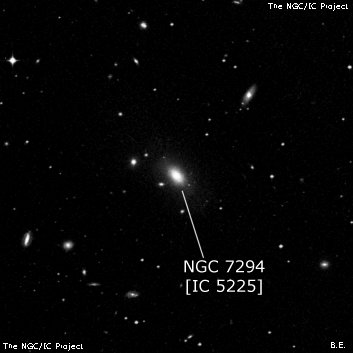
Francis Leavenworth discovered NGC 7294 = LM 1-251 in 1886 and recorded "vF, vS, R." His rough position (nearest min of RA) is 2 minutes of time preceding ESO 533-044. As his declination is a fairly close match, this identification is reasonable, despite the simple description. Lewis Swift independently discovered the galaxy on 6 Oct 1897 at age 77 and described Sw. XII-38 (later IC 5225) as "eeF; pS; R; betw 2 stars; a dozen stars in margin of field following, form semicircle, 4 st np a curve, one D, sp of 2 [should be np of 2, with IC 5226]. His position was 36 seconds of time too far west and 2' too far north, but his detailed description matches (specifically "4 st np a curve, one D[ouble]". So NGC 7294 = IC 5225. Herbert Howe measured an accurate position for NGC 7294 in 1898-99 that was repeated in the IC 2 Notes.
400/500mm - 17.5" (10/13/90): faint, small, round, bright core.
600/800mm - 24" (7/29/16): at 200x; fairly faint, moderately large, elongated ~3:2 SW-NE, ~60"x40", contains a brighter core that gradually increases to a small brighter nucleus. The core itself sometimes appears noticeably elongated SW-NE.
ESO 533-045 (possibly IC 5226) lies 16.6' SSE. It was fairly faint to moderately bright, slightly elongated, 1.2'x1.0', sharply concentrated with a very small brighter nucleus, low surface brightness halo. With careful viewing the core extended into a bar, elongated 2:1 SW-NE.
Notes by Steve Gottlieb